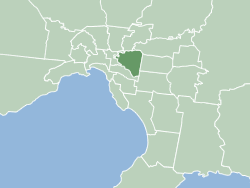City of Boroondara
|
City of Boroondara Victoria |
|||||||||||||
|---|---|---|---|---|---|---|---|---|---|---|---|---|---|

City of Harmony
|
|||||||||||||
| Population | 174,787 (2015) (30th) | ||||||||||||
| • Density | 2,910/km2 (7,500/sq mi) | ||||||||||||
| Established | 1994 | ||||||||||||
| Area | 60 km2 (23.2 sq mi) | ||||||||||||
| Mayor | Phillip Healey | ||||||||||||
| Council seat | Camberwell | ||||||||||||
| Region | Inner eastern metropolitan Melbourne | ||||||||||||
| State electorate(s) | Box Hill, Burwood, Hawthorn, Kew | ||||||||||||
| Federal Division(s) | Higgins, Kooyong | ||||||||||||
 |
|||||||||||||
| Website | City of Boroondara | ||||||||||||
|
|||||||||||||
The City of Boroondara (/bʊruːndˈɑːrɑː/ or /bɒruːndˈɑːrɑː/) is a local government area in Victoria, Australia. It is located in the eastern suburbs of Melbourne. It was formed in June 1994 from the amalgamation of the Cities of Kew, Camberwell and Hawthorn.
It has an area of 60 km². At the 2011 Census the City had a population of 159,184. Boroondara was rated ninth of 590 Australian local government areas in the BankWest Quality of Life Index 2008, and first in a 2013 Victoria-wide community satisfaction survey.
This area was originally occupied by the Wurundjeri Indigenous Australians of the Kulin nation.
In 1837, John Gardiner (after whom Gardiners Creek was named) and his family were the first Europeans to settle in the area. Robert Hoddle surveyed the area in 1837 and declared it the "Parish of Boroondara". The area was densely wooded, so he took a word from the Woiwurrung language (as spoken by the Wurundjeri), meaning "where the ground is thickly shaded".
...
Wikipedia
